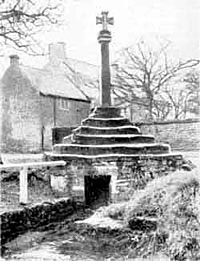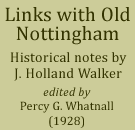< Previous | Contents | Next >
Linby Cross
 |
FROM the earliest Christian times, the Cross has been looked upon as a very sacred symbol, and its use has been manifold and widespread.
Before many of our most ancient churches were built the preaching station, which they came to dignify, was marked by a cross, so that the countryside might know whither to resort to hear the Gospel from the lips of the peripatetic missionaries of the times.
Churches were dedicated by the sign of the consecration cross, markets were enriched and sanctified, and business folk constantly reminded of their religion by the many market crosses to be found throughout the land, wayside crosses recalled the thoughts of travellers to higher planes, and in many other ways the cross entered into mediaeval life, always associated with sacred matters.
Small wonder, then, that it came to be looked upon with reverence not unmingled with awe, and when its sign was set upon a boundary mark it was regarded as an awful sin to remove it.
Linby has two crosses, an Upper and a Lower Cross, and they both appear to have been boundary crosses used in demarking the confines of the Forest of Sherwood.
The upper cross at the west end of the village is the older, its original shaft having been destroyed about 1564, and the modern restoration set up in 1869. Its seven-sided steps are unique in this neighbourhood, and may have some mystic meaning.
The lower cross, with its square steps, dates from about 1660, the time of King Charles II.’s restoration, and was set up instead of the old upper cross which had been destroyed a century or more before.
